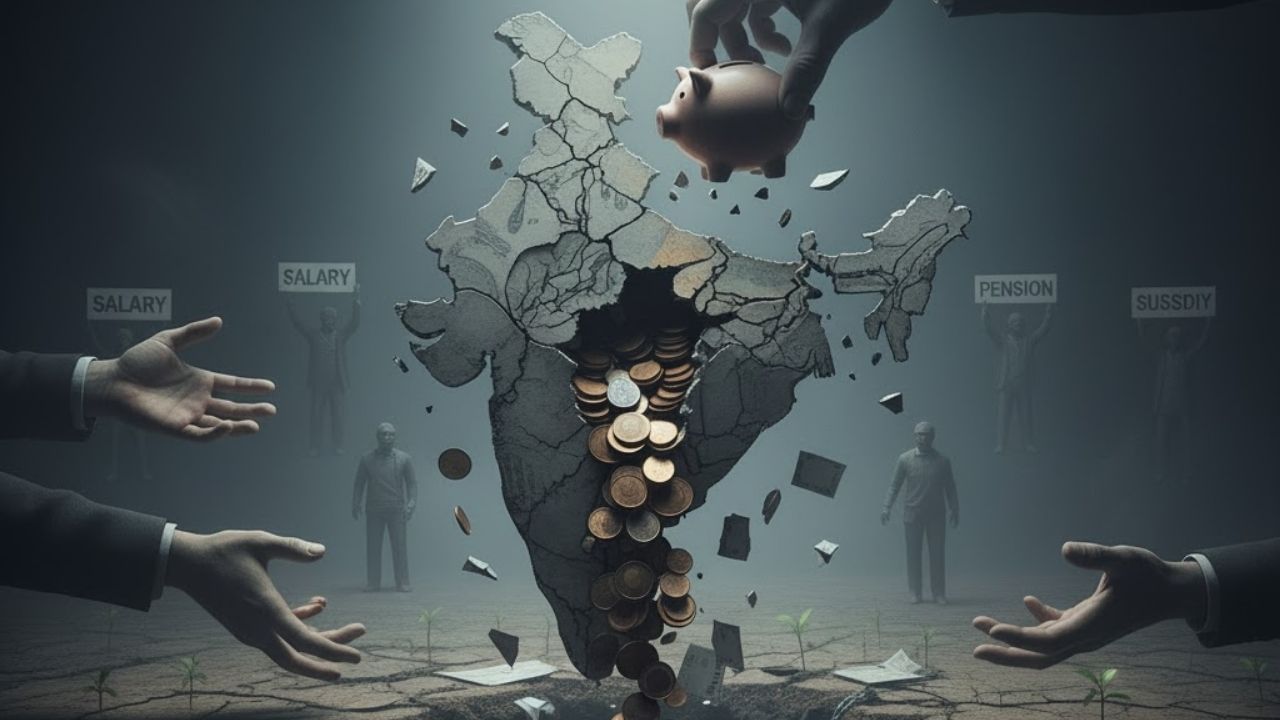PRS reportImage Credit source: google gemini
A shocking report has come out regarding the economic health of the states. PRS Legislative Research has released its report ‘State of State Finances 2025’, which gives the complete picture of the state of the exchequer of the states. It has been said in the report that many states are in revenue deficit, that is, their income has become less than their daily expenses. The direct effect of this is that they have to take loans for development projects, which is a worrying sign.
According to the report, there are many reasons behind the financial crisis of the states. A large part of the states’ income goes towards employees’ salaries, pensions and interest on old loans. Additionally, the number of unconditional cash transfer schemes providing cash directly to women has also increased in recent years, putting additional pressure on the treasury. The PRS report also shows how the coffers of the states are under constant pressure, they are getting trapped in the debt trap and their dependence on the Center is continuously increasing.
Why is the treasury of the states becoming empty?
The biggest revelation of the report is that many states continue to have revenue deficit. In 2023-24 it was 0.4 percent of GSDP. This simply means that the state is spending more than it is earning, and this expenditure is also on daily activities (like salaries, pensions) and not on the creation of any permanent assets (like schools, hospitals, roads). The matter of concern is that the state was able to collect on average 10 percent less revenue and spend 9 percent less than its budget estimates. The biggest reduction was in capital expenditure, which was reduced by 20 percent. That is, when there was shortage of money, the first thing to be cut was the development works.
Own tax revenue of the states is also very modest, which is only 6.8 percent of GSDP. The largest share in this is SGST. At the same time, even after the implementation of GST, the income generated from it is less than the taxes which were replaced by it. In 2015-16, revenue from old taxes was 6.5% of GDP, which has reduced to 5.5% in 2023-24 due to GST.
Revenues, subsidies and increasing debt burden
The biggest burden on the state exchequer is ‘Committed Expenditure’. In 2023-24, states spent 62 percent of their total revenue earnings only on salaries, pensions, interest payments and subsidies. Out of this, 53% went only towards salary, pension and interest. The condition of Punjab is the worst, which has spent more on these than its total revenue earnings. Himachal Pradesh, Tamil Nadu, Kerala and Haryana also spent more than 70 percent. In such a situation, where will the money be left for development works?
On top of that, the subsidy bill is continuously increasing. 24 states spent Rs 3.18 lakh crore on subsidies in 2023-24, almost half of which went to the power sector alone. RBI and Finance Commission are continuously warning that this increasing burden of subsidy is not good for financial stability.
A new expense has been added to this, that of cash transfer schemes to women. According to the budget of 2025-26, 12 states will spend Rs 1.68 lakh crore on these schemes. Of these, states like Karnataka and Madhya Pradesh, if they had not spent this, would have been in surplus instead of revenue deficit. RBI warns that such expenditure may lead to less money for productive works.
The result of all this is that a mountain of debt has arisen on the states. By March 2025, the total outstanding debt of states will be 27.5 percent of GSDP, whereas under the FRBM law this limit should be 20 percent. Only Gujarat, Maharashtra and Odisha are within this limit.
Dependence of states is increasing on the center
Due to less income, the dependence of the states on the central government has increased a lot. Especially the North-Eastern and Himalayan states get 68 percent of their total receipts from central transfers.
However, the Center had launched a scheme of 50-year interest-free loans (SASCI) to states for infrastructure creation in 2020-21. Under this scheme, states have received more than Rs 4 lakh crore. In 2024-25, 19 percent of the total capital expenditure of the states is expected to come from this loan.
But there is a catch in this too. There has been a decline in ‘untied’ funds received from the Centre. This is money which the state can spend anywhere as per its wish. In comparison to the 14th Finance Commission, this share decreased from 68% to 64% in the 15th Finance Commission. Even in SASCI loans, the unconditional portion has been reduced from 80% to 38%. This means that the Center is now giving money, but at the same time it is also telling where to spend it. Due to this, the autonomy of the states to make their own policies is reducing.
The gap between rich and poor states is becoming deeper
One of the most worrying aspects of the report is the growing economic gap between rich and poor states. High-income states, such as Maharashtra, Karnataka and Tamil Nadu, collect more revenue from their taxes and also spend more per capita. Due to this they are in a virtuous cycle of development. On the other hand, low-income states like Bihar, Jharkhand and Uttar Pradesh are stuck in a vicious cycle of limited revenue and low investment.
